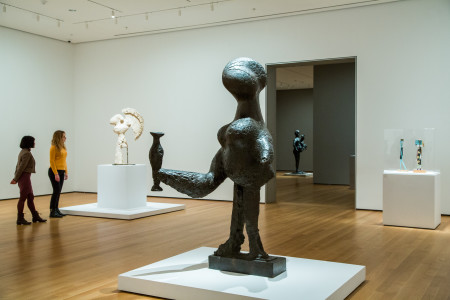REVIEW: ‘Picasso Sculpture’ displays alternate take on artist’s creativity

NEW YORK — The hugely successful Picasso Sculpture exhibition at the Museum of Modern Art may have closed last weekend, but its influence still lingers. The multi-gallery showcase of Pablo Picasso’s creative, unconventional sculpture work was a triumphant exploration into an alternative side of the iconic artist. Much heralded for his abstract masterpieces, including “Guernica,” Picasso was also a prolific sculptor who constructed his creations with a variety of materials, everything from wood to clay to bronze to found objects. Picasso Sculpture, which resided on MoMA’s fourth floor, was so special because it wasn’t the usual Picasso retrospective. The interpretation of the artist may never be the same again.
The galleries were set up chronologically, moving from one period of the artist’s life to the next. Visitors were first treated to his early 20th-century creations, several of which are quite traditional and simple. “Seated Woman” from 1902 is perhaps Picasso’s first sculpture; it’s only a few inches high and includes a woman leaning over her knees, one hand holding up her head. The sculpture is in stark contrast to his later works, which grew larger and more complex, although some of that simplicity remained throughout his career.
There’s an intricacy in “Head of a Picador With a Broken Nose,” a realistic bronze sculpture of a man’s face and his crooked nose. The Baltimore Museum of Art object has a realism to it that Picasso would later ditch for more abstract creations.
“The Jester” is another bronze sculpture, but this one almost looks like Picasso is heading away from realism. The figure, with his pointed hat, is smiling, but his skin and clothes are bumpy and drippy, showcasing a different technique with the bronze.
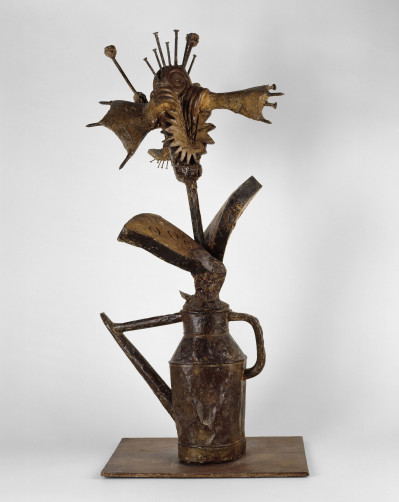
The simplicity, almost like Picasso was learning as he was creating, continues with “Head of a Woman (Fernande)” and “Kneeling Woman Combing her Hair.” Wood enters the picture with a 1907 “Head” on beech. Obviously influenced by other cultures’ art forms, Picasso created several sculptures that capture the unique shapes and faces of several figures.
“Head of a Woman” from 1909 is one of the highlights of the first gallery. The curved features of the woman’s hair and the saddened look of the face’s downward glance come together for a startling and effective bronze piece. A final “Apple” sculpture hints that Picasso is entering a more abstract realm.
The so-called Cubist Years feature some of Picasso’s iconic guitar sculptures, made with a combination of wood, sheet metal, paperboard and thread. They look so delicate and temporary, like they could fold in on themselves and be tucked into a desk. The abstract quality of these musical instruments is cleverly realized, and with their three-dimensionality, there’s almost a feeling of “putting together the pieces.” One can see the guitars or mandolin somewhere within the arranged objects, but they are scattered, displaying angles from left to right, inside to outside.
A series of smaller sculptures use household objects and paint. His “Glass of Absinthe” series couples painted bronze with an absinthe spoon. The resulting objects have a pedestal quality, almost as if the absinthe spoon is being heralded or praised upon a throne.
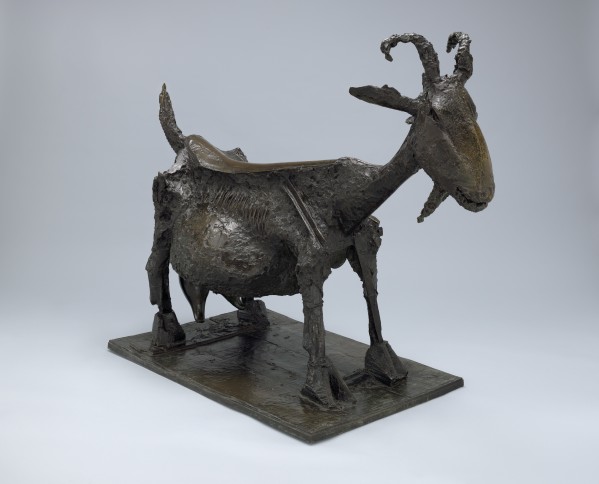
In the 1920s, Picasso created several figures that pivot away from his more traditional bronze work and abstract Cubist Years. These figures are skinny and mechanical, limbs represented by rods, heads represented by small spheres. The results are almost like geometric creations of how a person might be reduced to lines and shapes.
“Composition With Glove” features yet another right turn for the artist. This time he presents a glove, cardboard and plants in a collage format against the backdrop of a canvas. Everything is then coated with sand, giving it a gritty and aged look, as if the objects are lost in time, mummified. He repeats the technique with “Object With Palm Leaf.”
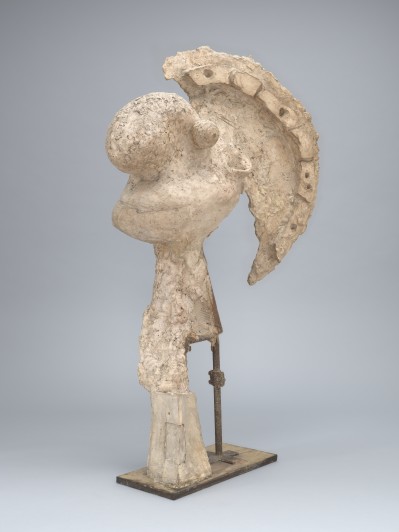
Picasso Sculpture leaves the smaller objects behind, and in the middle galleries, everything grows in size. “Head of a Man” and “Head of a Woman” are two highlights from the early 1930s. He’s presenting the human body in an abstract form, much like his iconic paintings, but his materials are almost as creative as his ideas. A metal colander, for example, is used for the “Head of a Woman,” while welded iron brings a “Woman in Garden” to life. The larger dimensions and unique abstractions also lend the sculptures some movement as if Picasso has captured them in stride.
The middle part of the exhibition features works from his Boisgeloup Sculpture Studio in the early 1930s. His series of standing and seated women, all of them skinny and created using fir, are yet another stylistic diversion for the artist. His “Bust of a Woman” and “Head of a Woman” starts a series of sculptures that showcase figures with exaggerated, sometimes phallic features. The eyes can be tennis-ball size, and the nose gains prominence. As he explored different avenues with these plaster creations, he also stuck with bronze for a series of “Bather” sculptures.
Not everything from the 1930s was large in size. Picasso also focused on a few parts of the human body or figures to showcase more detailed work. He has a “Hand” that looks almost life like and a “Bird” that takes a while to find in the plaster creation (Is that a wing? Is that its beak?).
The later Boisgeloup sculptures are some of the most fascinating in the entire exhibition. “Head of a Warrior” is something to behold, a massive creation of plaster, metal and wood that features a warrior in profile, the nose only outshone by the intricate, militaristic headpiece.
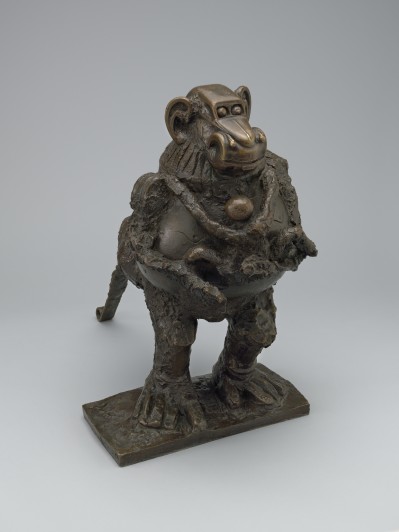
Other sculptures that beg for further introspection: “The Orator,” “The Reaper,” “Woman With Leaves” and “Woman With Orange or Woman With Apple,” this latter one certainly a highlight if for no other reason than its 71-inch gargantuan size.
Picasso, of course, was greatly affected by World War II, and the pressure of living in Europe during that time can be found in his work. “Death’s Head” is much more funereal than any of the other pieces in the show. Ditto for “Bull’s Head,” which features an upturned bicycle seat and handle bars. There’s even a sadness in the tissue-paper creations “Head of a Dog,” “Goat” and another “Death’s Head.”
“Man With a Lamb” is one of the tallest pieces in the exhibition, and “The Venus of Gas” is a found object (burner and pipe from a gas stove) that looks almost mythological.
One gallery is devoted to pictures of these sculptures. Picasso trusted Brassaï (Gyula Halász) to portray the sculptures in the right light and from the right angles. They’re most interesting for their shadow and lighting effects; however, seeing the actual creations in person is an unparalleled experience.
Finishing the exhibition, which took hours to complete thanks to the large number of items on display and large crowds, one could experience the ever-changing styles of this master. Earthenware vases were displayed next to plastered figures, which were displayed next to a “Seated Musician” made from fired red clay. His engraved pebbles, perhaps the smallest objects in the show, show a different side to an artist who seemed to favor the adjectives large and exaggerated.
“Pregnant Woman” features a host of materials, including pottery jars, and returns Picasso to life-size proportions. A “Flowery Watering Can” is beautiful, a dizzying array of metal parts and abstraction. “Baboon and Young” and “She-Goat” continue Picasso’s fascination with depicting animals.
There’s a wonderful illusion created with “Little Girl Jumping Rope.” The rope is on the ground, providing support for the sculpture, while the figure of the girl hangs in the air, almost impossibly so. “Woman With a Baby Carriage” is a fascinating bronze creation, striking for its size and humanity — a simple scene with a baby and his/her caretaker/parent.
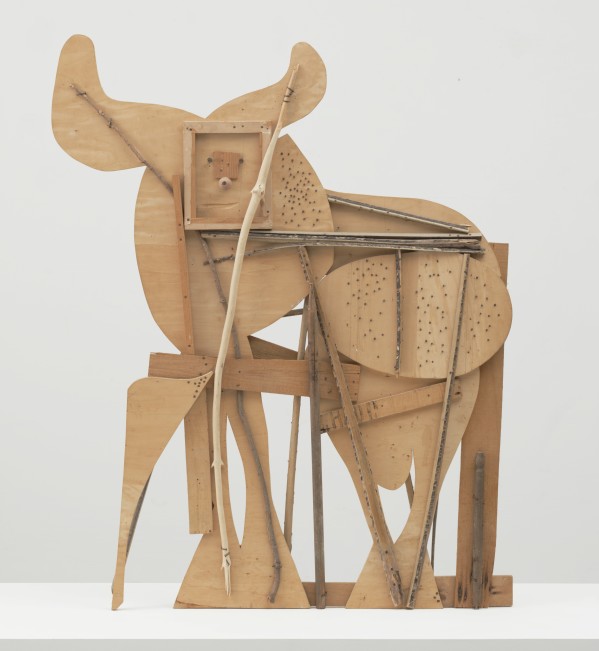
Several wood objects, including ones using blockboard, finish the exhibition. The most iconic is “Bull” from 1958. The shape is clearly of the animal, but the protruding bits and pieces make the piece feel unfinished with a behind-the-scenes quality as if the side on view is meant to be behind a theatrical curtain or against the wall.
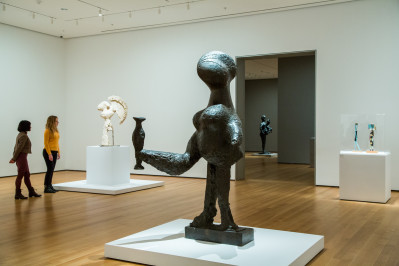
Picasso Sculpture finished with a final gallery that was located, oddly, next to the first gallery and past the entrance. This caused quite the confusion and traffic jam, but nothing could take away from the massive and massively creative retrospective. This was one of the most important exhibitions of the past few years and a hallmark event for MoMA. Visitors probably thought they knew Picasso inside and out, and now there needs to be even more consideration of this influential 20th-century artist.
By John Soltes / Publisher / John@HollywoodSoapbox.com
- Picasso Sculpture ended its run at the Museum of Modern Art Sunday, Feb. 7. For those who missed the exhibition, there is an accompanying book that offers pictures of the many objects on display. Click here for more information.

